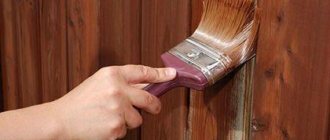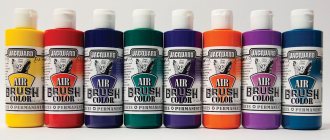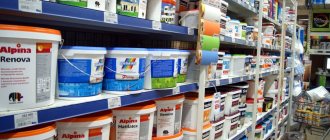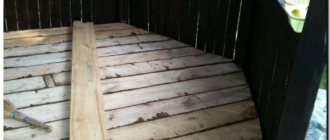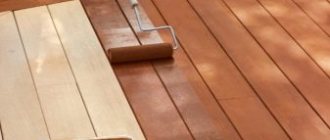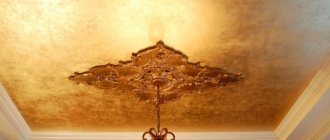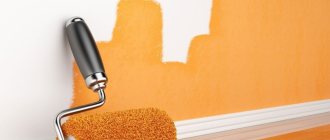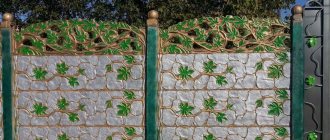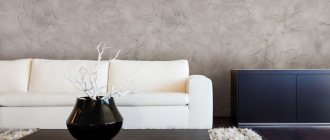Range of materials
The market for paints and varnishes amazes with its wide range. Such a variety of colors sometimes leads to a dead end. To make the right choice, you need to become better acquainted with each species.
There are several main types of dyes for metal fences:
- alkyd;
- oil;
- acrylic;
- universal.
Epoxy paint solutions can also be used for iron fences. However, it is worth remembering that they are highly toxic.
Important! When choosing paint, you should pay attention to its main characteristics: resistance to frequent changes in temperature and level of adhesion (adhesion to metal).
The basis of oil dyes is drying oil. This substance is made from natural oils. Such paints tolerate temperature increases up to 80°C. Their disadvantages include rapid fading and cracking. Painting an iron fence with oil paint is possible, but not recommended.
Alkyd paint compositions have more suitable properties. They have excellent adhesion to the surface, but are not resistant to high temperatures. Alkyd materials are ideal paint for galvanized metal.
Acrylic compounds are most suitable for painting metal fences. They have a lot of advantages:
- maintain an attractive appearance for a long period of time, do not fade or crack;
- protect iron products from corrosion and adverse environmental conditions;
- absolutely safe for people;
- differ in elasticity.
Universal paints are those that can be used to paint a completely unprepared surface. However, experts still advise not to neglect the preparatory process and first clean the metal of dirt, dust and old paint.
Separately, it is worth mentioning dyes that can be applied even to rusty surfaces. They have a unique feature, painting over rust and protecting the metal from subsequent destruction. They can be used to paint a fence made of ferrous metals, cast iron or steel.
If the fence is made of non-ferrous metal, it is better to choose paints based on organic solvents or acrylic. They will help create a coating that is resistant to corrosion.
Preparing the surface for painting
Before you start painting, you should clean the surface of dirt and rust, first degrease and dry it, and then phosphate or prime the corrugated sheet.
Particularly rusty or load-bearing structures should be phosphated. Phosphosoil phosphating compound is suitable for galvanized corrugated sheets. It is first applied to the surface of the sheet, followed by drying for 3-12 hours, depending on the air temperature.
Only after completing all the preparatory procedures can you begin to directly apply paint to the surface.
A regular alkaline solution based on washing powder is suitable for degreasing the surface. After washing, the remaining detergent is washed off with clean water under low pressure, and the sheet is left to dry completely.
If there is rust on the surface of the corrugated sheet, then you should definitely get rid of it using fine-grained sandpaper. This will increase adhesion and increase the adhesion of the paint to the surface. Additionally, you can prime the surface or immediately coat it with enamel (if priming is not required).
When using acrylic paints, you may not get rid of rust deposits in cracks. It can be applied directly to the surface of the corrugated sheet. Special components in the composition transform rust and prevent its appearance in the future.
depositphotos
Application technique
A few years ago, the work process consisted of three main stages: surface preparation, priming and painting itself. Now you can skip one of the stages, because paints have appeared on sale that can be applied directly to metal.
First you need to prepare all the tools and materials:
- container for dye;
- brush, roller or spray;
- sandpaper for sanding the surface.
The first stage is preparing the paint. It must be thoroughly mixed using a construction mixer or a regular stick. If you need to get any shade, you can mix two colors. Under no circumstances should you mix different types of paint. You should not mix those solutions to which a solvent has already been added.
Very often you can see clumps or film in a newly opened paint can. This indicates that it was stored incorrectly.
Most likely, the dye has lost its properties and has become unsuitable for further use.
The second stage is preparing the surface to be painted. Using the simplest means, you need to clean the metal from dirt, dust, etc. After this, use special means to get rid of rust. Don't forget about a layer of old paint. You can try to remove it with sandpaper. If this does not help, it is recommended to use a brush with metal bristles or other special products. If necessary, coat the fence with a primer.
DIY metal fence painting scheme
The last stage is painting. To get high-quality coverage, you should listen to several recommendations from experts:
- Fences made of non-ferrous metals should be painted in two layers. The first is a special base composition that improves adhesion. The second is the chosen paint. The second layer can be applied a day after applying the first.
- It is better to pour the dye from a large package into a smaller container. This will reduce consumption and keep the paint in good condition.
- A fence that consists of several metal rods will be easier to paint with a medium-hard flat brush.
- For large, smooth fences, a roller is suitable. The process will go faster with it.
- If the fence consists of several separate parts, they can be painted before installation. In this case, you can use a spray bottle.
Bitumen mastic
Bituminous mastic is widely used in various construction works as a protective and waterproofing material. In the case of support pillars, it is necessary to process that part of the pipes that will be buried or cemented. This will help protect the metal from water and salts dissolved in it. Fence support posts can be painted prior to installation. At the same time, the drying time increases, since the lower plane is not painted, and it is simply difficult to work with round material. In addition, the finished surface can be damaged quite easily. Therefore, it is better to apply paint after installation.
If welding work is expected, then the coating must be applied after completion, carefully cleaning the weld seams!
Powder type of dye
A spray bottle will also be needed if powder dye is chosen for painting. The coating created with its help has its advantages:
- attractive appearance;
- strength;
- long service life;
- safety;
- resistance to exposure to adverse environmental conditions;
- fire safety.
Powder paints come in several types. They differ in their composition:
- Epoxy is made from resins.
- Epoxy-polyester is a mixture of two types of resins in equal quantities.
- Polyester contains polyester resins of artificial origin.
Painting with powder dyes is carried out in several steps:
- Surface preparation. This stage includes stripping the metal of old paint, dirt, rust, etc.
- Spraying of coloring composition. This procedure must be carried out in a special chamber using special spray guns.
- The last stage is the most difficult and most responsible. This is a heat treatment of a metal structure. It is carried out in a special oven. After the procedure, the product is cooled.
Due to the fact that powder painting requires many additional devices, it is not done at home. It is carried out by specialized companies.
How to paint a metal fence?
In addition, after reading, you will be able to independently calculate the cost of painting.
In most cases, newly installed metal fences do not require additional processing, since conscientious companies use high-quality galvanized materials, which have already been coated with proven compounds using modern technologies.
Photo #1: newly installed metal fence
Those property owners who erected an unpainted fence themselves, ordered the installation of unfinished structural elements, or were faced with the need to update the topcoat should review the recommendations below.
Color and decorative solution
Nowadays, choosing a paint of the desired shade and effect will not be difficult, because their range is simply amazing. Dyes can be glossy, matte or semi-matte. If the store doesn't have the color you want on the shelves, you can make it yourself. To do this, you will need to purchase a color scheme or mix two or more different colors. Computer programs for creating shades will help speed up the procedure.
There are coloring compounds on sale that give the surface an additional effect. This may be the effect of deformation, aged surface, etc.
Methods for painting corrugated sheets
Today, a wide variety of corrugated sheet coloring options are offered. What means are used for this? These include polymer compounds such as plastisol, polyester, PVDF, various enamels, and polymer powder paints. The technology of its application will also depend on the choice of paint and varnish.
Galvanized corrugated sheeting can be painted in several ways:
- electrostatic painting;
- combined;
- airless;
- pneumatic
Let's consider these methods in more detail. The airless method consists in the fact that the paint and varnish material is supplied under pressure into the nozzle, and as it exits, this pressure decreases. In this case, the air becomes a brake, reducing the speed of paint flow, which falls evenly on the corrugated sheet.
With this coloring option, colorful mist is not formed, and the productivity coefficient is quite high. Among the disadvantages is the quality, which is slightly inferior to pneumatic painting. Using the airless method, only flat shapes can be painted.
A pneumatic sprayer is a device for uniformly painting corrugated sheets.
Pneumatic paint spraying involves using highly compressed air to spray. The quality of the corrugated sheet surface to be painted will depend on the shape of the spray torch, the speed of paint flow, the ratio of spot area and air speed. But this method produces a strong paint mist, which is very uneconomical.
The combined painting method involves the paint moving under high pressure. The paint goes on smoothly and the consumption is quite economical. The electrostatic method is considered the most economical, but this method is difficult to paint problem areas such as corners, sharp surfaces, and depressions.
The most popular method today is powder painting of corrugated sheets, with which you can easily and quickly coat any surface with a layer of paint.
The technology for coating corrugated sheets with powder paints is very simple:
- the surface is first thoroughly cleaned and degreased;
- after this, the sheet is processed to obtain a phosphate film on the surface to increase adhesion;
- coating a sheet of corrugated sheets using a powder sprayer, the paint is applied evenly, very quickly, in a uniform, durable layer;
- polymerization of paint at high temperatures up to two hundred degrees for ten to fifteen minutes.
Some tips
There are several recommendations that, if followed, will make the work process easier and make the coating more durable and attractive:
- When priming, do not use a roller. Moisture and air will get into small cracks and holes. Because of this, the structure will rust faster.
- There are optimal conditions for painting. This is an air temperature from +5 to +40°C and humidity in the range of 80-85%.
- The more solvent added to the paint, the more transparent the layer will be.
- When using a spray bottle the layer will be smoother.
You can paint a metal fence in two ways: yourself, using, for example, acrylic dye, or using powder paint in special chambers. Which one should you choose? It depends on capabilities and preferences. Both options will help extend the life of the structure and protect it from exposure to adverse environmental conditions.
DIY fence painting technology
The use of raw materials does not require special skills or special equipment. The main thing is to buy good quality metal paint and follow the technology:
- Remove dirt from the surface with soapy water.
- If painting will be done with a roller, foam rubber should be discarded.
- It is better to paint the structure horizontally, apply the paint in small portions and distribute it with a roller.
- Use a brush to go over small elements and hard-to-reach places.
- The paint is applied quickly, the same place is not treated twice, this will visually lead to the appearance of defects.
- The pneumatic control panel must be held strictly straight, completely painting all areas and details.
Working with Hammerite paint is very easy. This is a 3 in 1 product: primer, protection against corrosion processes and decorative coating. Suitable not only for metal, but also other materials.
